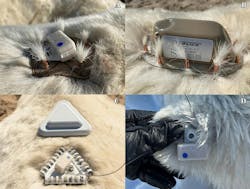Noninvasive Trackers Monitor Polar Bears by Satellite
What you’ll learn:
- How animals could be tracked in the future.
- New ways sensor data is taken from animals in the wild.
- Low-power sensors and how they work.
Polar bears are the largest species of carnivores to roam in the Arctic and surrounding areas. Although they’re the sisters to the brown bear, they've evolved to handle the harsh conditions of their natural habitat. Polar bears are typically solitary, but they can be found in groups while on land, especially during mating season, where males will guard females from rivals.
As you might imagine, polar bears inhabit a large portion of the Arctic. They have a range that stretches from Greenland to Alaska, and have been found as far north as 16 miles to the North Pole and as far south as the Pribilof Islands of Alaska.
Researchers have been tracking polar bears for decades to gain insight into their behaviors, populations, and migration areas, especially those seasons that correlate with the movement of ice packs. Most polar bears will stay with the ice pack as it melts and moves north and travel south as the ice packs advance.
With the rise in global temperatures, those migrations have become affected. In fact, the International Union for Conservation of Nature (IUCN) has recently classified polar bears as a vulnerable species, with the biggest threats being climate change, pollution, and energy development.
Over the years, scientists have studied those migration habits primarily using trackers via ear tags and collars outfitted with transmitters. However, the process of tagging the bears is invasive, meaning the scientists must first sedate the bears and then perform minor invasive procedures to prevent the tags from falling or being torn off.
Over the last several years, researchers from York University, University of Alberta, Environment and Climate Change Canada, Manitoba Sustainable Development, Ontario Ministry of Natural Resources and Forestry, and Polar Bears International have developed a new method of tracking that doesn't require invasive procedures. It’s known as “Burr on Fur” (see figure).
New Ways to Obtain Sensor Data from Animals in the Wild
GPS and satellite-linked radio tracking collars and ear tags remain the main methods of tracking polar bears. In 2020, though, Polar Bears International (PBI) proposed a technological challenge to invent a better way to track the bears, and 3M, the makers of Post-It notes, answered the call. The company designed several prototype satellite trackers that are nontoxic, temporary, and affixed to the bear's fur rather than the skin.
A total of 58 wild polar bears were tagged with traditional transmitters (equipped with Argos transmitters) alongside the new prototypes, which were used to compare the amount of time the tags remained active while attached to the bears as well as the accuracy of the trackers. The three prototype tags include:
- The Pentagon Tag: A five-sided device equipped with an Argos Eartag Satellite transmitter that had five holes punched into its corners, allowing tufts of fur to be pulled through and secured.
- The SeaTrkr Tag: An oval-shaped tag equipped with an iridium-linked Telonics GPS SeaTrkr-4370 transmitter with 10 holes punched to allow for 10 fur-tuft attachment points.
- The Tribrush Tag: A triangle tag equipped with an Argos Eartag Satellite transmitter outfitted with tubes along its borders, through which pipe brushes ensnared the fur, twisting it inside the tubes.
The researchers tested the trio of new tracking devices near Churchill, Canada, between 2016 and 2021, with the results showing the SeaTrkr Tag as the number one performer. They remained with the bears for 58 days and offered superior accuracy due to its iridium/GPS technology. Second place went to the Tribrush Tag, which remained on the bears for an average of 47 days. Of course, the traditional ear tags lasted the longest at 137 days on average.
How Animals Could be Tracked in the Future
The fur tags proved useful for short-term tracking and monitoring polar bear behavior. They showed great promise for future, noninvasive tracking, especially with bears that get too close to communities and settlements and must be relocated. The researchers are also testing the trackers at zoos and aquariums to further refine the designs and see how they fare during the seasons. The most recent test saw a refined tag stay in place for 75 days!
The new data acquired while testing in the field added to a growing understanding of male polar bear behavior and movements, which have been understudied as they’re difficult to collar for long periods. What the researchers found during testing was that adult and sub-adult males reduce their activities while on land, spending 70% to 90% of their time resting during the ice-free period in Hudson Bay.
The researchers state that tracking tech could be implemented on other types of bears to gain insight into reducing human-bear interaction. They could even be used to test other species of animals with fur.
About the Author
Cabe Atwell
Technology Editor, Electronic Design
Cabe is a Technology Editor for Electronic Design.
Engineer, Machinist, Maker, Writer. A graduate Electrical Engineer actively plying his expertise in the industry and at his company, Gunhead. When not designing/building, he creates a steady torrent of projects and content in the media world. Many of his projects and articles are online at element14 & SolidSmack, industry-focused work at EETimes & EDN, and offbeat articles at Make Magazine. Currently, you can find him hosting webinars and contributing to Electronic Design and Machine Design.
Cabe is an electrical engineer, design consultant and author with 25 years’ experience. His most recent book is “Essential 555 IC: Design, Configure, and Create Clever Circuits”
Cabe writes the Engineering on Friday blog on Electronic Design.


